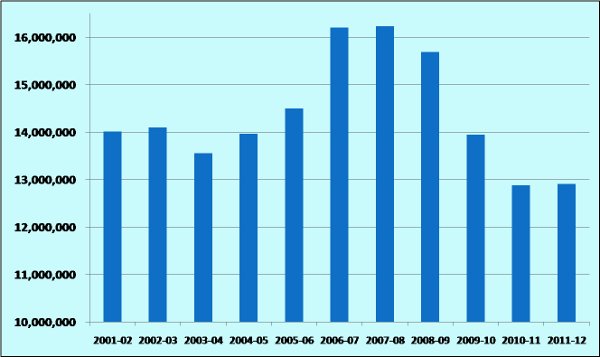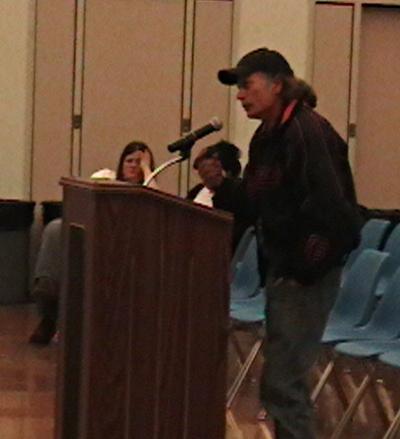LUCERNE – Faced with a proposed series of water rate hikes totaling over 68 percent for the coming three years, close to 100 Lucerne residents attended a public hearing on Thursday where they voiced opposition to the plans.
The California Public Utilities Commission (CPUC) hosted the meeting, which lasted nearly two and a half hours, at the Lucerne Alpine Senior Center.
California Water Service Co., which owns Lucerne's water system, is seeking rate increases of 54.9 percent in 2011, 7 percent in 2012 and 6.6 percent in 2013, based on its application.
Many of the Lucerne residents who came to speak against the increases pointed to the county's high unemployment. The most recent unemployment figures for Lake County made available by the state, which are for the month of December, show an overall unemployment rate of 18.5 percent, with Lucerne's specific rate at 19.3 percent.
As well, many argued that the seniors and disabled who make up a larger portion of the Lucerne area's more than 3,000 residents – based on the most recent US Census figures – are on fixed incomes and aren't receiving any cost of living adjustments.
Other complaints during the meeting included questions about the three surcharges on water bills, unreadable meters, people having their water shut off even when they're paid up, and still others facing poverty and having to decide between water and food.
Still others would point to Cal Water's “windfall” profit and stockholder returns, which they said are coming on the backs of ratepayers who already are struggling to pay their bills.
The San Jose-based company, which bills itself as the “largest investor-owned American water utility west of the Mississippi River and the third largest in the country,” has more than 460,000 customers throughout California.
The company reported Feb. 24 that its 2009 revenues increased 10 percent, or $39 million, to $449 million.
Cal Water is proposing the rate increases to make new distribution system upgrades – including installing new water pipeline – and to add new jobs.
Administrative Law Judge Jeffrey O'Donnell led the hearing, which was taped and will be transcribed by a court reporter who attended to take notes.
O'Donnell explained the rates that the company was seeking – to which some people yelled out “Violation!”
He said the CPUC was holding the meeting because it wanted to hear from the community. The CPUC's Division of Ratepayer Advocates (DRA)n and Cal Water representatives were there to answer questions.
“I fully understand you're not in love with the idea of this rate increase that's proposed,” said O'Donnell.
“I fully understand that you're really pissed off,” he told the audience. “And, frankly, if I was sitting out there instead of here, I would be, too.”
O'Donnell said his job was to be a neutral party in the decision making process.
Explaining the rate hike process, O'Donnell said a utility company files an application and provides documents to support their rate increase request.
For the current Cal Water rate increase request, just the company's first round of reports constituted about five file boxes, O'Donnell said.
In turn, the DRA – which advocates for ratepayers as a whole – has investigated the company's documents and put forth their own reports, he explained.
An evidentiary hearing is set for about two weeks from Lucerne's meeting, said O'Donnell, and after that there will be a month-long pause during which the DRA and other intervenors will submit briefs.
Eventually, all of that work will lead to O'Donnell's decision, which he said the CPUC can accept or, alternately, give its own.
O'Donnell said his job is to make the best recommendation he can based on the evidence in the record. He assured the audience that he has read all of the letters and e-mails the CPUC has received from the community about the rate increase proposal.
Before public comment began, O'Donnell invited Cal Water and DRA representatives up to the microphone to give brief presentations.
Darin Duncan, Cal Water's rates manager, pledged to the audience that he would take all of their comments from the meeting back to the corporate offices in San Jose.
He said Cal Water filed general rate increases for all of its 24 operating districts on July 2, 2009. Duncan said the state now requires multidistrict utilities like Cal Water to file all rate cases at the same time.
“This was a pretty big undertaking,” he said, explaining the company gave the DRA 25 to 30 file boxes of documents.
Lucerne, he said, is a standalone part of the Redwood Valley District, which also covers parts of Guerneville and Dillon Beach. Rate increase meetings have been held in other parts of the district.
In Lucerne, the company is seeking a $682,000 increase for 2011, or 54.9 percent, Duncan said.
Companywide, Cal Water is requesting $70.6 million across 24 districts, or a 16.75-percent systemwide increase in 2011, Duncan said. A Cal Water mailer for the meeting noted that it's also seeking $24.7 million, or 5.04 percent, in 2012 and $24.7 million, or 4.79-percent, in 2013.
Lucerne's proposed rate increase for 2011 is three times the companywide average.
“I realize people are struggling int his economy. It's not our No. 1 thing to do, to go out and ask for a 54-percent increase,” Duncan said.
One man yelled from the audience, “Come on man, you're a corporation!”
Duncan added that the company has low income ratepayer support funds.
DRA engineer Patrick Hoglund said they have engineers, attorneys and accountants who have reviewed Cal Water's recommendations, and looked at the company's Lucerne' facilities.
Hoglund said the DRA's job is to make recommendations to the commission that they believe are reasonable, and will allow Cal Water to continue to provide reliable service.
Public criticizes company service; residents say water rates already too high
First to the microphone during public comment was District 3 Supervisor Denise Rushing, who also sits on several county-run water districts.
When Cal Water purchased the system, “I am certain that they got a little more than they bargained for in terms of the system condition,” she said.
Systems around Lake County are requiring “a substantial amount of investment,” Rushing said.
That creates a challenge at a time when Rushing said the county is facing depression-era unemployment levels.
Rushing – who also has previous experience in the utility industry – said Cal Water purchased the Lucerne system for a reason, and because of the rules under which they operate, they figured they could invest and then get a return on it through cost recovery.
“But in this day and age it might be time to question those rules,” she said.
While Cal Water is proposing to use its rate increases to add employees, Rushing said the county is finding ways to do more with less with its systems.
The high rate increase for Lucerne will degrade the county's efforts to turn the local economy around, and when it comes to disadvantaged communities like Lucerne, Rushing said the investor model needs to be questioned.
“Sometimes you just have to spend what you can afford and not what you're allowed to spend,” she said, receiving a round of applause as she returned to her seat.
County Deputy Redevelopment Director Eric Seely followed Rushing to the microphone, explaining that the agency is charged with trying to bring jobs to communities like Lucerne.
That's a task made more challenging by the uncertainty of current and future Cal Water rate hikes, Seely said. The redevelopment agency is concerned about the increases as it works with business owners to show them Lucerne is a good place to locate.
At the same time, Seely said the county is a Cal Water customer, utilizing water for facilities like county-owned parks, one of which currently is being expanded with a new pier.
Craig Bach of the Lucerne Community Water Organization (LCWO) handed O'Donnell a petition with 275 signatures against the rate hikes.
“We just don't have the money,” he said.
Bach said the community has been overcharged for its new water plant, which required three designs and $7 million to complete. “We'd like to pay for the plant we actually got,” and not the two previous designs, Back said.
Referring to 25 new job positions that the company wants to add for about $17 million over a five-year period, Bach said Cal Water asked for new positions in two previous rate hikes, but failed to hire those jobs, to the tune of $4 million.
Between that $4 million and the proposed $17 million, Bach suggested, “I think we can get a break, folks.”
Frank Parker asked why the company was asking for $1.5 million for upgrades to its new plant, or for increased benefits for employees based on inflation. Parker said he recently received a letter from Social Security telling him he would not receive an increase.
The county government is facing layoffs, and in Lucerne there are vacant houses that can't be sold due to the already high water rates, Parker said.
He said the plant's cost overruns were unreasonable, and alleged that the company made unsubstantiated management decisions about what technologies to adopt. Then they did three plant designs and only used one.
“Why should we pay for their mistakes?” he asked.
Citing the company's millions of dollars in profit for last year, Parker asked when the company was going to start using profits to operate, rather than keep raising the rates. “We need some relief.”
Charles Moton said Cal Water seems oblivious to the current tough economic times.
Besides the troubles nationwide, in Lucerne people are leaving to seek work and opportunities elsewhere, he said. “The utilities always make money, regardless of economic conditions.”
But water is needed to live, and Cal Water has captive consumers. While the stock market and indexes were down the previous day, Moton noted that Cal Water's stock numbers were up.
Asking for money at this time is “grasping, avaricious and just plain greedy,” he said.
Gary Barrious asked if the company could charge all customers across the state 25 cents per bill to help cover the costs of Lucerne's improvements.
“The simple answer is, that is already happening,” said Duncan, with every Cal Water customer paying less than a penny a unit, which goes into the rate support fund.
O'Donnell asked Duncan to respond to the issues of the three plant designs. “What gives?” he asked.
When Cal Water took over the plant and system, both were in disrepair and dilapidated, said Duncan. The company first focused on upgrading the treatment plant.
He said Clear Lake, because of its algae and water quality issues, is “very difficult to treat.” Cal Water couldn't get permits for an initial treatment plant design that they abandoned.
Ultimately, the design they went with is a “state of the art” plant that uses advanced oxidation and an ultraviolet light process to purify the water. “It's the best water quality that you can get,” Duncan said.
Most of the rate increases the company now is seeking are for improvements to the aging pipeline, which is mostly made of 2-inch galvanized pipe put in place in the 1940s and 1950s, Duncan said. Cal Water's 2009 budget included 3,250 feet of pipeline upgrade, a little over 1,000 feet is included in the 2010 budget and another 1,000 feet or so is scheduled for replacement in 2012.
The company can hold off a little while on those pipe replacements, but Duncan said they must do it at some point, as it makes no sense to build a new plant and have old pipes.
Company engineer Maurice Francis explained that Cal Water had challenges during the construction phase because the initial plans were inadequate. The company couldn't use the first two design plans – which he said came from two of the nation's top consultants – because the costs were “overwhelming.”
So the company decided to go back to the drawing board and hire another consultant to create the design that ultimately was built. Francis said the plant was completed last September.
John Foth, Cal Water's rate case project manager for whom the Lucerne plant is a temporary assignment, said the new plant was funded by a no-interest loan from the state revolving loan fund. Customers pay a monthly surcharge to help pay back that loan.
He said the loan was for $7.1 million, but the plant's total cost exceeded that by about $900,000. The company is earning returns on that additional $900,000.
Lucerne's rates higher than other areas
Dr. Wilson Goddard, an environmental engineer and a Lucerne resident for more than 20 years, said the system worked well under the previous ownership of Bob and Nadine Strauss, who he said had repairs made quickly and efficiently.
He compared Lucerne's rates to those in Cal Water's San Mateo district. In San Mateo, Goddard said Cal Water customers pay an $8.75 meter charge. “Our meter charge is $32.58,” Goddard said.
Along with those meter charges, Lucerne's customers are paying other fees for a total base charge of $53.70. Goddard said San Mateo's charge for one “ccf” – or 100 cubic feet – of water is $3.03; for the same amount of water, Lucerne customers pay $5.45.
San Mateo's median income, based on the 2000 US Census, is $95,750, versus Lucerne's $25,345, Goddard said. The number of people in San Mateo considered to be at the poverty level total 7.1 percent, compared to 15.8 percent in Lucerne. Goddard added that 26.1 percent of Lucerne's families are at the poverty level.
Christine Goddard asked how inflation factors are calculated for the company's rates. O'Donnell asked Hoglund to explain. Hoglund said DRA has within it a separate group of staff that develops rates, using data similar to that used by the federal government.
In his turn, Charles Behne – a member of Lucerne Friends of Locally Owned Water – said in 2005 the CPUC gave Cal Water a 111-percent rate increase, but a DRA audit in 2008 showed that the company didn't hire the people or buy the equipment it planned to, resulting in a $2.5 million windfall for the company.
The DRA's evaluation of the latest rate increase shows that Cal Water is asking for similar increases, Behne said. “I think it's time for the CPUC to give the ratepayers a significant windfall.”
O'Donnell asked company representatives about what happens when customers can't pay their bills. Duncan said service usually is turned off within a few months if customers don't pay, although Gay Guidotti, manager for the Redwood Valley district, say they entertain all requests for payment arrangements.
Responding to Goddard's comparisons between Cal Water's Lucerne and San Mateo districts, Duncan said the company buys water from the San Francisco Public Utilities Commission water that's already treated for $1.68 a unit. They then put on a markup to cover service costs.
San Mateo has a customer base of more than 35,000, said Duncan. “Those costs are spread over a larger base of customers.”
In his explanation, Duncan did not offer comparable costs for water purchase or the customer base for Lucerne. Lake County News has requested those numbers for a followup article.
Resident Greg Larson brought with him a 2002 Cal Water bill, which had one service charge for $25.80 and a $1.17 charge per cubic foot of water. His latest bill had a per-cubic-foot charge of $5.44, a service charge of $65.16 plus two additional service charges totaling around $30.
“We need some protection from these people,” Larson said, telling the CPUC and DRA representatives, “You gotta help us.”
Company representatives later in the meeting would explain that the additional surcharges were to pay back state-issued, zero-interest loans for the treatment plant.
Lucerne residents also questioned the water quality. Ted Shimizu said he had found bad-smelling green and orange “stuff” growing in his sink.
Later in the meeting, Sam Silva, a Cal Water water quality expert, said they have to adjust treatment to the lake's conditions, and they rely on reports from customers.
Rushing suggested that in a small community like Lucerne, where income levels are dropping and vacancy rates are rising, the ratemaking structure doesn't work.
“This is not the ideal community for this kind of rate system,” she said, because the community can't afford it.
Daniel Mohle, a disabled Lucerne resident who once was a business owner, said that when he made adjustments to his business it came out of his own pocket.
“You want to build a $7 million plant, you build it, not us,” he said. “You want to modify something? You pay for it, not us.”
Moton, who returned to the microphone briefly, said that after hearing about the company going through three plant designs before getting it right, “I feel like I'm living in a 'Dilbert' cartoon.”
He asked if the CPUC checks to make sure the rates Cal Water applies for are fair and in keeping with other industries. Hoglund said yes, they do look at “normal, reasonable costs.”
As the meeting drew to a close, O'Donnell told meeting attendees that DRA, CPUC and Cal Water representatives would stay afterward until 10 p.m. to answer questions one-on-one.
As to the final decision, “I can't tel you what the results are going to be” he said, adding that he has five file boxes of papers to read.
“We will be considering what you've had to say today,” O'Donnell said.
Comments can still be sent to O'Donnell about the rate hike.
Send comments referencing Application No. 09-07-001 to the CPUC Public Advisor's Office, 505 Van Ness Ave., San Francisco, CA 94102; e-mail This email address is being protected from spambots. You need JavaScript enabled to view it. . The office also may be contacted via phone at 866-849-8390 or 415-703-2074.
E-mail Elizabeth Larson at This email address is being protected from spambots. You need JavaScript enabled to view it. . Follow Lake County News on Twitter at http://twitter.com/LakeCoNews and on Facebook at http://www.facebook.com/pages/Lake-County-News/143156775604?ref=mf .












